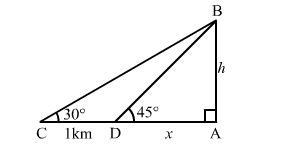From the top of a hill, the angles of depression of two consecutive km stones due east are found to be 30° and 45°.
From the top of a hill, the angles of depression of two consecutive km stones due east are found to be 30° and 45°. The height of the hill is
(a) $\frac{1}{2}(\sqrt{3}-1) \mathrm{km}$
(b) $\frac{1}{2}(\sqrt{3}+1) \mathrm{km}$
(c) $(\sqrt{3}-1) \mathrm{km}$
(d) $(\sqrt{3}+1) \mathrm{km}$
(b) $\frac{1}{2}(\sqrt{3}+1) \mathrm{km}$
Let $A B$ be the hill making angles of depression at points $C$ and $D$ such that $\angle A D B=45^{\circ}, \angle A C B=30^{\circ}$ and $C D=1 \mathrm{~km}$.
Let:
$A B=h \mathrm{~km}$ and $A D=x \mathrm{~km}$

In $\triangle A D B$, we have:
$\frac{A B}{A D}=\tan 45^{\circ}=1$
$\Rightarrow \frac{h}{x}=1 \Rightarrow h=x$ .......(i)
In $\Delta A C B$, we have:
$\frac{A B}{A C}=\tan 30^{\circ}=\frac{1}{\sqrt{3}}$
$\Rightarrow \frac{h}{x+1}=\frac{1}{\sqrt{3}}$ .........(ii)
On putting the value of $h$ taken from (i) in (ii), we get:
$\frac{h}{h+1}=\frac{1}{\sqrt{3}}$
$\Rightarrow \sqrt{3} h=h+1$
$\Rightarrow(\sqrt{3}-1) h=1$
$\Rightarrow h=\frac{1}{(\sqrt{3}-1)}$
On multiplying the numerator and denominator of the above equation by $(\sqrt{3}+1)$, we get:
$h=\frac{1}{(\sqrt{3}-1)} \times \frac{(\sqrt{3}+1)}{(\sqrt{3}+1)}=\frac{(\sqrt{3}+1)}{3-1}=\frac{(\sqrt{3}+1)}{2}=\frac{1}{2}(\sqrt{3}+1) \mathrm{km}$
Hence, the height of the hill is $\frac{1}{2}(\sqrt{3}+1) \mathrm{km}$.
Click here to get exam-ready with eSaral
For making your preparation journey smoother of JEE, NEET and Class 8 to 10, grab our app now.
